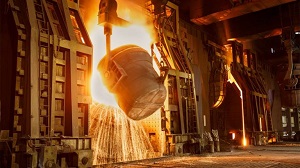Modern processes in the manufacturing of steel
The methods of steel manufacturing evolved significantly with the beginning of industrial production at the end of the 19th century. However, modern methods are based on Bessemer process. According to the World Steel Association, in 2011, raw steel production reached a new record of 1.527 billion metric tons. Of these, about two-thirds were made using BOS (basic oxygen steelmaking) process and one-third was made using EAF (electric arc furnace).

EAF – Unlike other processes, the one that uses the electric arc furnace generates high temperatures by means of electricity. The first such oven was designed by Paul Heroult. This is a technology that uses 100% scrap steel.
The furnace is divided into three sections: case, fireplace and roof. The process begins by lifting the roof and electrodes, loading the scrap steel, reducing agents and alloying elements; then, the electrodes are inserted and the roof is placed back. By means of these three graphite electrodes, a temperature of approximately 3500 degrees Celsius is created and the melting process takes place. Once the entire charge is melted, a sample is taken which shall be analyzed to determine the oxygen quantity to be blown for refining. For refining, the chemical composition is adjusted to meet the requirements of the product. The electric arc furnace has a 300-ton capacity, and the manufacturing process takes about 40-60 minutes.
The advantage of this process is that it may be stopped and started without associated high costs.
Another advantage is that it may only use recycled materials. For these reasons, the EAF process has grown steadily over the past 50 years, now being used in 33% of the world’s steel production.
BOF – In 1960, the development of a method for the separation oxygen from nitrogen on industrial scale allowed major progress in the development of the basic oxygen steelmaking furnace. Most large-scale production is achieved through the melting process by means of basic oxygen.
Molten iron with recycled scrap is poured into a large converter, coated with heat-resistant bricks.
Then, a water-cooled tube is inserted till its tip reaches above the melted metal. Pure oxygen is blown through this tube, which reacts with the carbon in iron, making sufficient heat to keep the charge melted. To maintain a temperature of 1600 degrees Celsius, quick lime and other melting materials are gradually added, as needed. When the oxygen is blown, carbon monoxide and other gases are released, forming sinter. It is required to blow 20-30 minutes for a 400-ton converter. The released gases are vacuumed by some fans, and at the end of the process the sinter is removed. The resulting steel is either cast in molds for the manufacturing of molded pieces, or is cast in ingots to be rolled down. This seems to be the most convenient process; besides the fact that it is quick, the fuel consumption is very low.
<< Inapoi